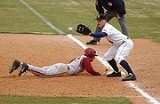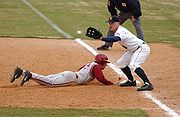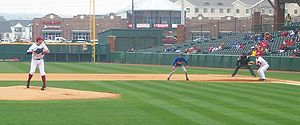
Pickoff
Encyclopedia

Baseball
Baseball is a bat-and-ball sport played between two teams of nine players each. The aim is to score runs by hitting a thrown ball with a bat and touching a series of four bases arranged at the corners of a ninety-foot diamond...
, a pickoff is an act by a pitcher
Pitcher
In baseball, the pitcher is the player who throwsthe baseball from the pitcher's mound toward the catcher to begin each play, with the goal of retiring a batter, who attempts to either make contact with the pitched ball or draw a walk. In the numbering system used to record defensive plays, the...
or a catcher
Catcher
Catcher is a position for a baseball or softball player. When a batter takes his turn to hit, the catcher crouches behind home plate, in front of the umpire, and receives the ball from the pitcher. This is a catcher's primary duty, but he is also called upon to master many other skills in order to...
, throwing a live ball
Live ball (baseball)
In baseball, when the ball is alive , the game can proceed. The pitcher may pitch the ball , the batter may attempt to hit such a pitch, baserunners may attempt to advance at their own risk, and the defense may attempt to put the batter or baserunners out.-Definition:The ball becomes live when the...
to a fielder
Infielder
An infielder is a baseball player stationed at one of four defensive "infield" positions on the baseball field.-Standard arrangement of positions:In a game of baseball, two teams of nine players take turns playing offensive and defensive roles...
so that the fielder can tag out
Tag out
In baseball, a tag out, sometimes just called a tag, is a play in which a baserunner is out because he is touched by the fielder's hand or glove holding a live ball while the runner is in jeopardy...
a baserunner who is either leading off
Lead off
In baseball, the term lead off or lead-off has two distinct meanings:- On the bases :In baseball, to lead off, or to take a lead, refers to the position a baserunner takes just prior to a pitch, a short distance away from the base he occupies. A "lead" can also refer to that distance. A typical...
or about to begin stealing
Stolen base
In baseball, a stolen base occurs when a baserunner successfully advances to the next base while the pitcher is delivering the ball to home plate...
the next base.
A pickoff attempt occurs when this throw is made in an attempt to make such an out or, more commonly, to "keep the runner close" by making it clear that the pitcher is aware and concerned with the runner's actions. A catcher may also attempt to throw runners out who likewise "stray too far" from their bases after a pitch; this can also be called a pickoff attempt. A runner who is picked off is said to have been caught napping, especially if he made no attempt to return to his base.
A pickoff move is the motion the pitcher goes through in making this attempt; some pitchers have better pickoff moves than others. Pitchers in professional baseball use the pickoff move often, perhaps several times per game or even per inning
Inning
Inning is a municipality in the district of Erding in Bavaria in Germany....
if speedy baserunners reach base. Pitchers with more confidence in their ability to eliminate batters directly via strikeouts or flyouts use fewer pickoff attempts. In lower-skilled amateur games, the pickoff move is less common due to the potential for an error
Error (baseball)
In baseball statistics, an error is the act, in the judgment of the official scorer, of a fielder misplaying a ball in a manner that allows a batter or baserunner to reach one or more additional bases, when such an advance would have been prevented given ordinary effort by the fielder.The term ...
if the pitcher throws wild or the fielder fails to make the catch. In youth leagues that don't allow leading off, such as Little League
Little League
Little League Baseball and Softball is a non-profit organization in South Williamsport, Pennsylvania, United States which organizes local youth baseball and softball leagues throughout the U.S...
and Cal Ripken League, the need for a pickoff move is eliminated.
Technique

Balk
In baseball, a pitcher can commit a number of illegal motions or actions that constitute a balk. In games played under the Official Baseball Rules, a balk results in a dead ball or delayed dead ball. In certain other circumstances, a balk may be wholly or partially disregarded...
s.
When there is a baserunner on, the pitcher will pitch from the stretch, one of the pitching position
Pitching position
In baseball, there are two legal pitching positions: the windup, and the set. Each type of pitching position has its strengths and weaknesses. Compared to the set, the windup takes a relatively slower execution, so therefore is better suited for situations in which there are no baserunners, or when...
s. For this example we will say the runner is on first base. From the set position the pitcher can still see the baserunner out of the corner of his eye, if it is a right-handed pitcher. If it is a left-handed pitcher then the pitcher has a clear view of the baserunner because of the way they are standing on the pitcher's mound. If it is a right-handed pitcher there is only one main method of this pickoff move. This involves a quick shuffle of the pitcher's feet to turn towards first base and throw the ball to the first baseman. The first baseman will then attempt to tag out the runner. The left-handed pitcher, due to their natural stance and the way they are facing, has multiple moves. The two main methods are called the "snap throw" and "spin move". The snap throw is when the pitcher quickly lifts his back foot behind the pitching rubber and slings the ball to the first baseman. A snap throw can also refer to the catcher throwing the ball to the base following a pitch. The spin move is when the pitcher lifts his leg like he is going to pitch the ball but then rotates his body toward first and throws the ball. The pitcher will try to vary this move by doing this move while looking at the runner or at the batter, which can be deceiving to the baserunner. The final pickoff move can be done by any pitcher called "third to first" and can only be done if there are baserunners on first and third. This move is very uncommon and used almost entirely by right-handed pitchers only, but it's performed by the pitcher attempting to pick off a baserunner at third, stop, spin and throw the ball to first base instead. This move can be useful in trying to get the base-runner or the batter to disclose what action they were going to perform on the pitch. Former Kansas City Royals right-hander, Steve Busby
Steve Busby
Steven Lee Busby is a former starting pitcher in Major League Baseball who played his entire career for the Kansas City Royals . He batted and threw right-handed.-Professional career:...
is credited for popularizing the "third to first" move.
Two active pitchers particularly renowned for their pickoff technique are Andy Pettitte
Andy Pettitte
Andrew Eugene Pettitte is a retired American left-handed Major League Baseball starting pitcher.In his major league career, he played for the New York Yankees from 1995–2003. He then signed with the Houston Astros, and played for them from 2004 through 2006. In 2007, Pettitte rejoined the Yankees...
and Mark Buehrle
Mark Buehrle
Mark Alan Buehrle is a Major League Baseball left-handed pitcher. He has pitched his entire baseball career for the Chicago White Sox, starting the opening game every season from 2002 to 2006 and again from 2008 to 2011....
, both left-handed pitchers.
Purpose
There are a few reasons to resort to this tactic:- To tag out the base-runner. Sometimes the runner will run on the first move of the pitcher. If the pitcher successfully throws the ball to the base before the base-runner is able to return to it, then the defense will be able to tag outTag outIn baseball, a tag out, sometimes just called a tag, is a play in which a baserunner is out because he is touched by the fielder's hand or glove holding a live ball while the runner is in jeopardy...
the runner. - To prevent a stolen base. If a fast base-runner is leading off the base by a large margin, the pitcher will throw over to the base a few times to try to get the base runner to shorten his lead, thus deterring him from stealing. After enough throws the runner will often either shorten his lead or tire from diving back, preventing him from stealing a base.
- The runner will often take a few steps off the base in order to have a head startHead start (positioning)In positioning, a head start is a start in advance of the starting position of others in competition, or simply toward the finish line or desired outcome...
toward the next base. The runner will generally not go too far away from the base so if the pitcher does throw, he can return safely. But the pitcher will hope to catch the runner off-guard.
- The runner will often take a few steps off the base in order to have a head start
- To extract information from the offense. For example, if the defense suspects a bunting situation, the pitcher may throw over to first in hopes that the batter will square around to bunt on the pitcher's first move, revealing his intention.
- To buy time for a relief pitcher to be prepared to come into the game. This is seen quite often in the major leagues, as the pitcher in the game picks multiple times in a row in an effort to waste time so that his replacement can warm up adequately.

